1997 Asian Financial Crisis: Causes, Effects, and Recovery
VerifiedAdded on 2023/04/04
|11
|2239
|146
AI Summary
This paper provides an analysis of the 1997 Asian financial crisis, including its causes, effects, and recovery. It explores how countries like Malaysia, Thailand, South Korea, Singapore, the Philippines, and Indonesia were affected by the crisis and how they implemented policies to recover. The paper also discusses the role of the government and central banks in solving the crisis.
Contribute Materials
Your contribution can guide someone’s learning journey. Share your
documents today.
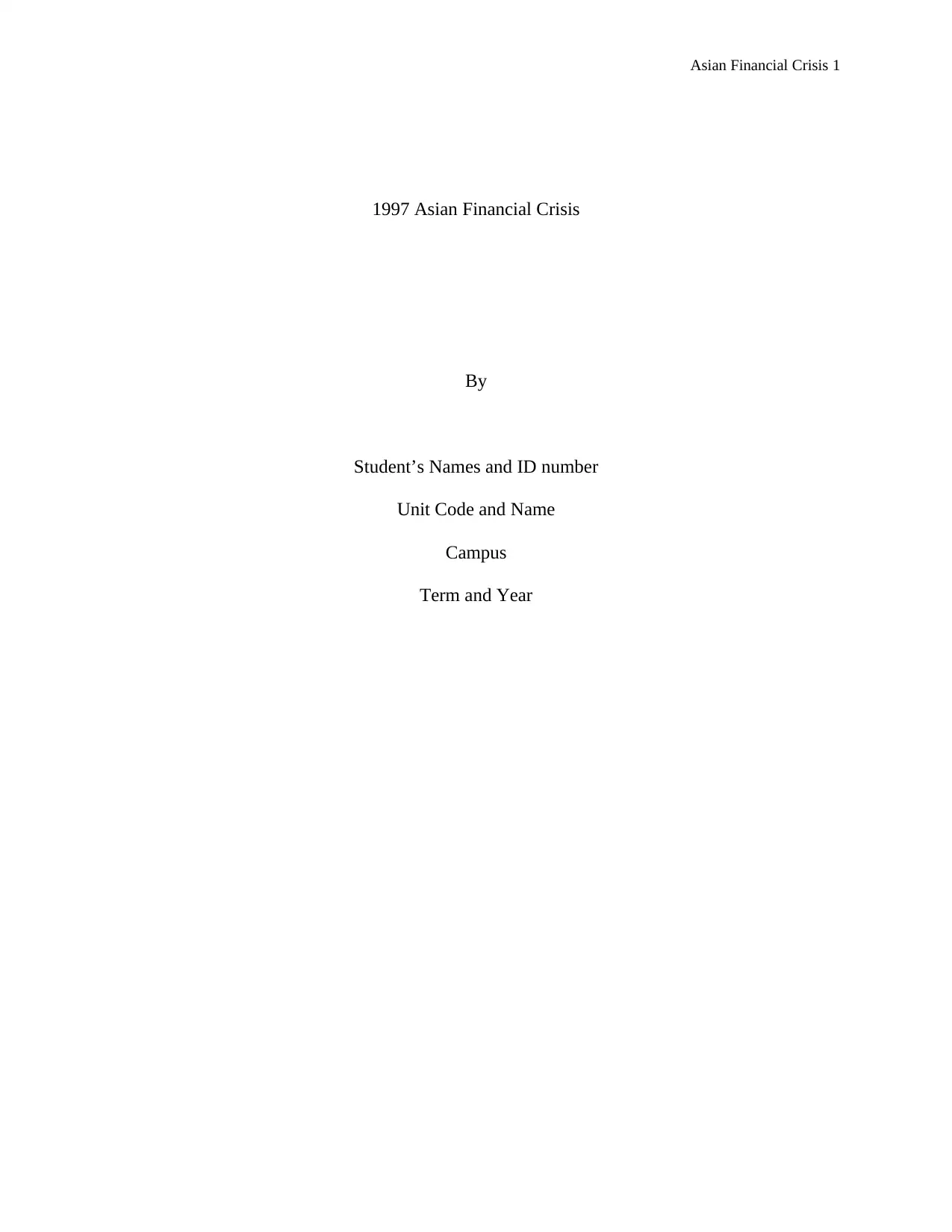
Asian Financial Crisis 1
1997 Asian Financial Crisis
By
Student’s Names and ID number
Unit Code and Name
Campus
Term and Year
1997 Asian Financial Crisis
By
Student’s Names and ID number
Unit Code and Name
Campus
Term and Year
Secure Best Marks with AI Grader
Need help grading? Try our AI Grader for instant feedback on your assignments.
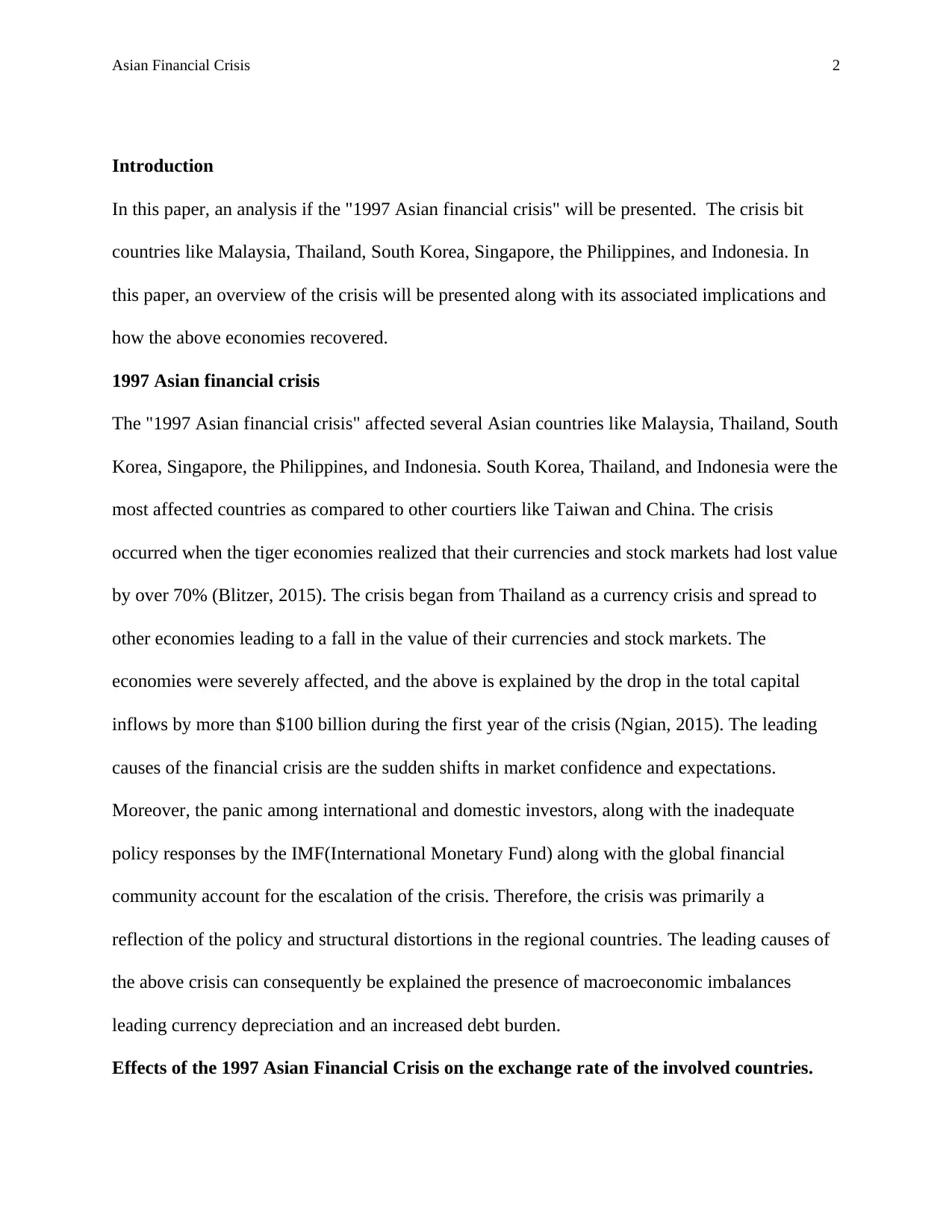
Asian Financial Crisis 2
Introduction
In this paper, an analysis if the "1997 Asian financial crisis" will be presented. The crisis bit
countries like Malaysia, Thailand, South Korea, Singapore, the Philippines, and Indonesia. In
this paper, an overview of the crisis will be presented along with its associated implications and
how the above economies recovered.
1997 Asian financial crisis
The "1997 Asian financial crisis" affected several Asian countries like Malaysia, Thailand, South
Korea, Singapore, the Philippines, and Indonesia. South Korea, Thailand, and Indonesia were the
most affected countries as compared to other courtiers like Taiwan and China. The crisis
occurred when the tiger economies realized that their currencies and stock markets had lost value
by over 70% (Blitzer, 2015). The crisis began from Thailand as a currency crisis and spread to
other economies leading to a fall in the value of their currencies and stock markets. The
economies were severely affected, and the above is explained by the drop in the total capital
inflows by more than $100 billion during the first year of the crisis (Ngian, 2015). The leading
causes of the financial crisis are the sudden shifts in market confidence and expectations.
Moreover, the panic among international and domestic investors, along with the inadequate
policy responses by the IMF(International Monetary Fund) along with the global financial
community account for the escalation of the crisis. Therefore, the crisis was primarily a
reflection of the policy and structural distortions in the regional countries. The leading causes of
the above crisis can consequently be explained the presence of macroeconomic imbalances
leading currency depreciation and an increased debt burden.
Effects of the 1997 Asian Financial Crisis on the exchange rate of the involved countries.
Introduction
In this paper, an analysis if the "1997 Asian financial crisis" will be presented. The crisis bit
countries like Malaysia, Thailand, South Korea, Singapore, the Philippines, and Indonesia. In
this paper, an overview of the crisis will be presented along with its associated implications and
how the above economies recovered.
1997 Asian financial crisis
The "1997 Asian financial crisis" affected several Asian countries like Malaysia, Thailand, South
Korea, Singapore, the Philippines, and Indonesia. South Korea, Thailand, and Indonesia were the
most affected countries as compared to other courtiers like Taiwan and China. The crisis
occurred when the tiger economies realized that their currencies and stock markets had lost value
by over 70% (Blitzer, 2015). The crisis began from Thailand as a currency crisis and spread to
other economies leading to a fall in the value of their currencies and stock markets. The
economies were severely affected, and the above is explained by the drop in the total capital
inflows by more than $100 billion during the first year of the crisis (Ngian, 2015). The leading
causes of the financial crisis are the sudden shifts in market confidence and expectations.
Moreover, the panic among international and domestic investors, along with the inadequate
policy responses by the IMF(International Monetary Fund) along with the global financial
community account for the escalation of the crisis. Therefore, the crisis was primarily a
reflection of the policy and structural distortions in the regional countries. The leading causes of
the above crisis can consequently be explained the presence of macroeconomic imbalances
leading currency depreciation and an increased debt burden.
Effects of the 1997 Asian Financial Crisis on the exchange rate of the involved countries.
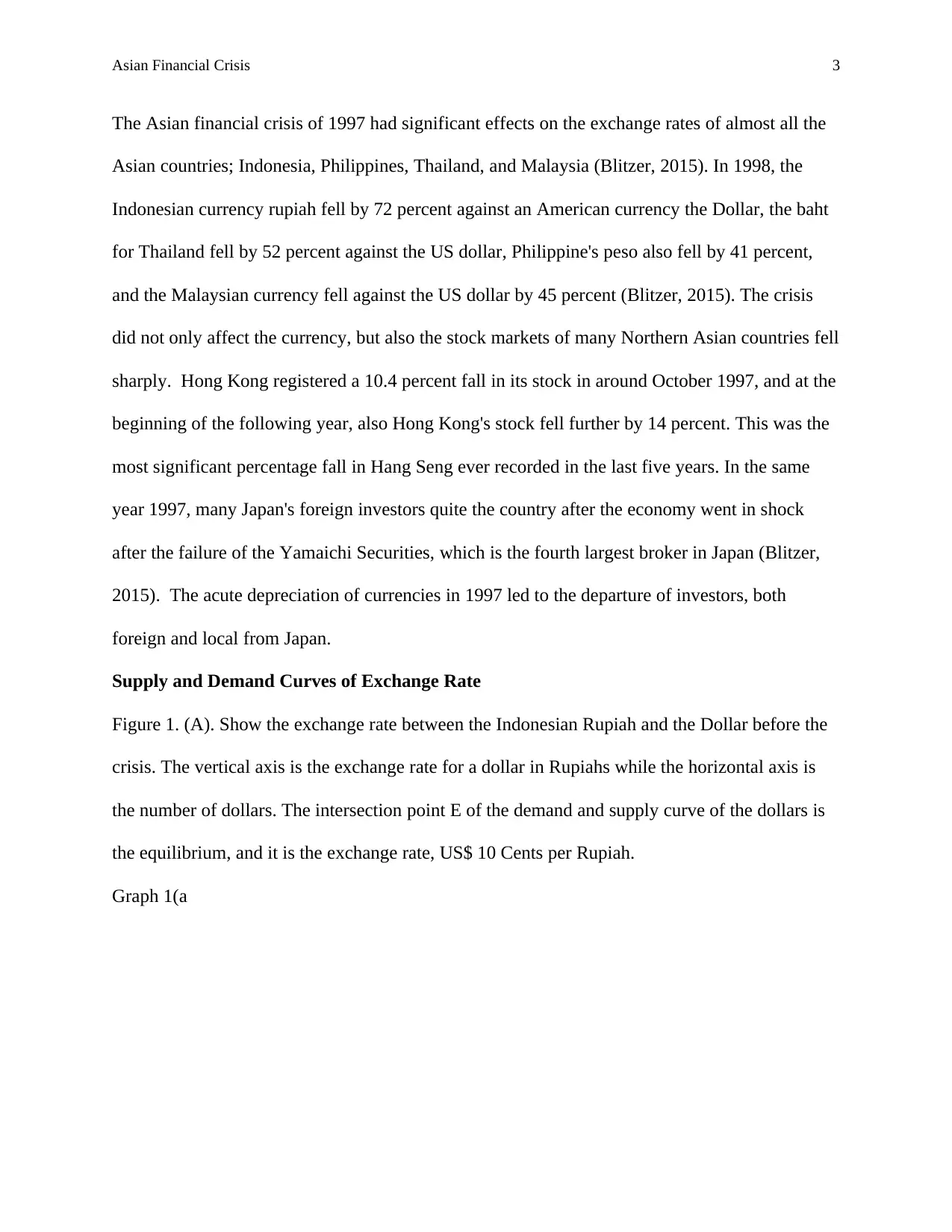
Asian Financial Crisis 3
The Asian financial crisis of 1997 had significant effects on the exchange rates of almost all the
Asian countries; Indonesia, Philippines, Thailand, and Malaysia (Blitzer, 2015). In 1998, the
Indonesian currency rupiah fell by 72 percent against an American currency the Dollar, the baht
for Thailand fell by 52 percent against the US dollar, Philippine's peso also fell by 41 percent,
and the Malaysian currency fell against the US dollar by 45 percent (Blitzer, 2015). The crisis
did not only affect the currency, but also the stock markets of many Northern Asian countries fell
sharply. Hong Kong registered a 10.4 percent fall in its stock in around October 1997, and at the
beginning of the following year, also Hong Kong's stock fell further by 14 percent. This was the
most significant percentage fall in Hang Seng ever recorded in the last five years. In the same
year 1997, many Japan's foreign investors quite the country after the economy went in shock
after the failure of the Yamaichi Securities, which is the fourth largest broker in Japan (Blitzer,
2015). The acute depreciation of currencies in 1997 led to the departure of investors, both
foreign and local from Japan.
Supply and Demand Curves of Exchange Rate
Figure 1. (A). Show the exchange rate between the Indonesian Rupiah and the Dollar before the
crisis. The vertical axis is the exchange rate for a dollar in Rupiahs while the horizontal axis is
the number of dollars. The intersection point E of the demand and supply curve of the dollars is
the equilibrium, and it is the exchange rate, US$ 10 Cents per Rupiah.
Graph 1(a
The Asian financial crisis of 1997 had significant effects on the exchange rates of almost all the
Asian countries; Indonesia, Philippines, Thailand, and Malaysia (Blitzer, 2015). In 1998, the
Indonesian currency rupiah fell by 72 percent against an American currency the Dollar, the baht
for Thailand fell by 52 percent against the US dollar, Philippine's peso also fell by 41 percent,
and the Malaysian currency fell against the US dollar by 45 percent (Blitzer, 2015). The crisis
did not only affect the currency, but also the stock markets of many Northern Asian countries fell
sharply. Hong Kong registered a 10.4 percent fall in its stock in around October 1997, and at the
beginning of the following year, also Hong Kong's stock fell further by 14 percent. This was the
most significant percentage fall in Hang Seng ever recorded in the last five years. In the same
year 1997, many Japan's foreign investors quite the country after the economy went in shock
after the failure of the Yamaichi Securities, which is the fourth largest broker in Japan (Blitzer,
2015). The acute depreciation of currencies in 1997 led to the departure of investors, both
foreign and local from Japan.
Supply and Demand Curves of Exchange Rate
Figure 1. (A). Show the exchange rate between the Indonesian Rupiah and the Dollar before the
crisis. The vertical axis is the exchange rate for a dollar in Rupiahs while the horizontal axis is
the number of dollars. The intersection point E of the demand and supply curve of the dollars is
the equilibrium, and it is the exchange rate, US$ 10 Cents per Rupiah.
Graph 1(a
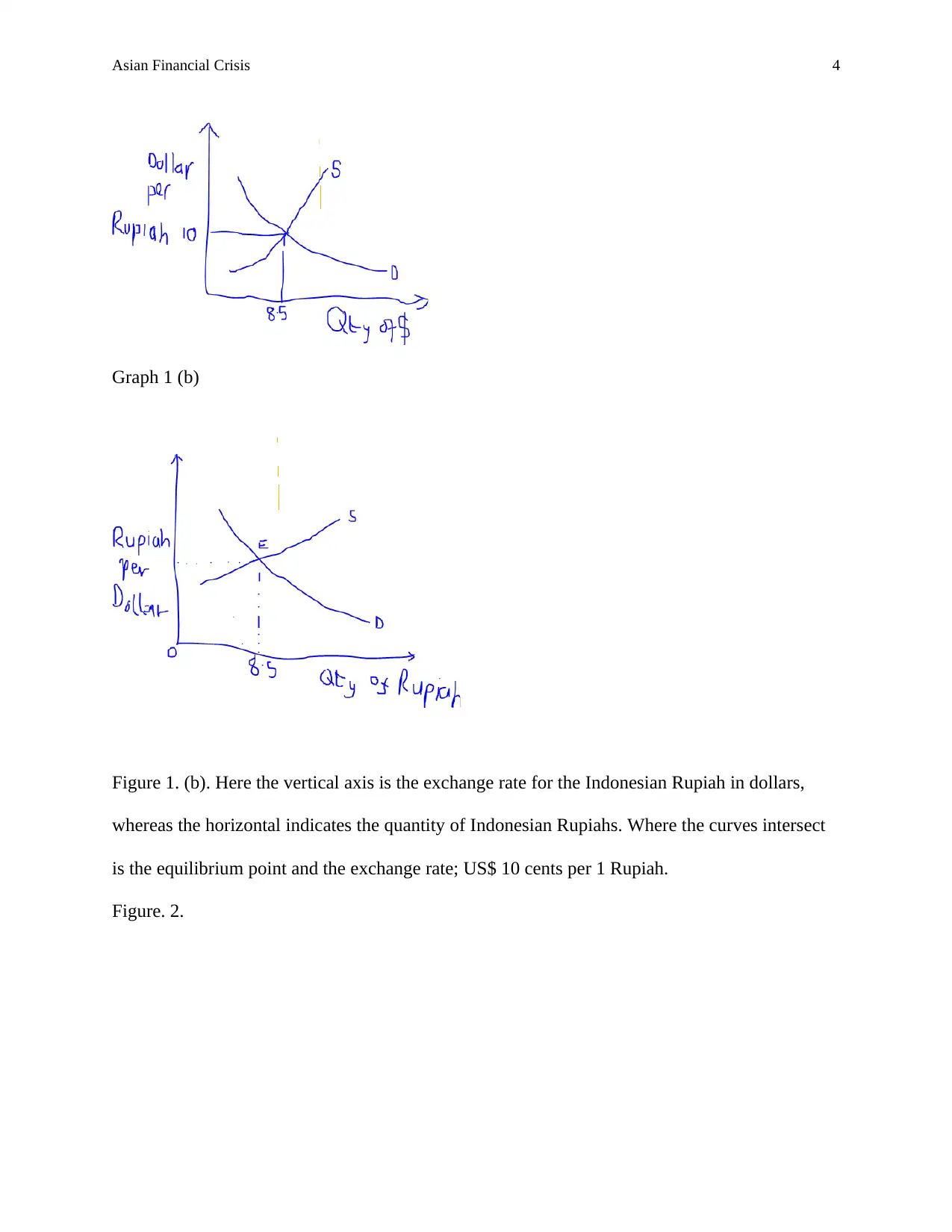
Asian Financial Crisis 4
Graph 1 (b)
Figure 1. (b). Here the vertical axis is the exchange rate for the Indonesian Rupiah in dollars,
whereas the horizontal indicates the quantity of Indonesian Rupiahs. Where the curves intersect
is the equilibrium point and the exchange rate; US$ 10 cents per 1 Rupiah.
Figure. 2.
Graph 1 (b)
Figure 1. (b). Here the vertical axis is the exchange rate for the Indonesian Rupiah in dollars,
whereas the horizontal indicates the quantity of Indonesian Rupiahs. Where the curves intersect
is the equilibrium point and the exchange rate; US$ 10 cents per 1 Rupiah.
Figure. 2.
Secure Best Marks with AI Grader
Need help grading? Try our AI Grader for instant feedback on your assignments.
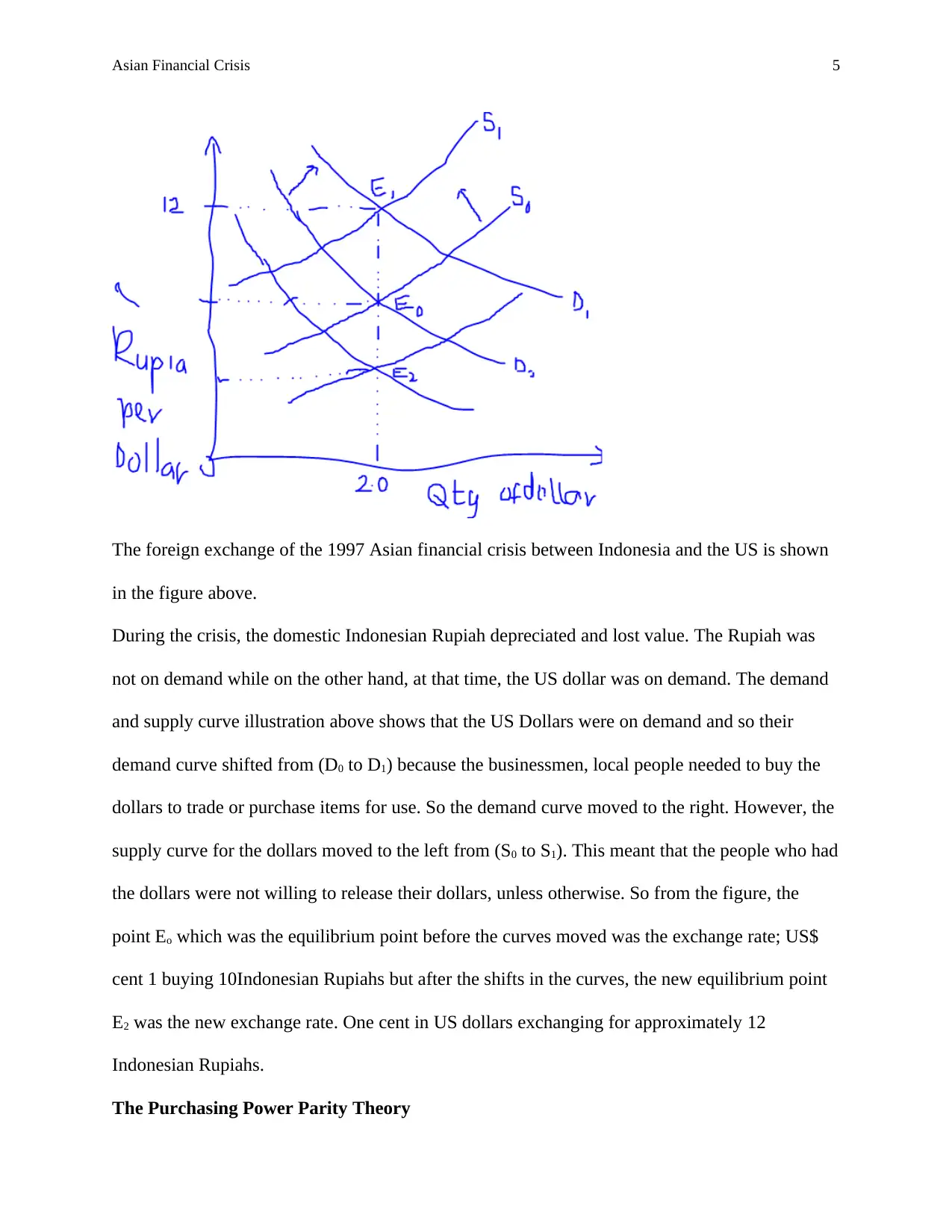
Asian Financial Crisis 5
The foreign exchange of the 1997 Asian financial crisis between Indonesia and the US is shown
in the figure above.
During the crisis, the domestic Indonesian Rupiah depreciated and lost value. The Rupiah was
not on demand while on the other hand, at that time, the US dollar was on demand. The demand
and supply curve illustration above shows that the US Dollars were on demand and so their
demand curve shifted from (D0 to D1) because the businessmen, local people needed to buy the
dollars to trade or purchase items for use. So the demand curve moved to the right. However, the
supply curve for the dollars moved to the left from (S0 to S1). This meant that the people who had
the dollars were not willing to release their dollars, unless otherwise. So from the figure, the
point Eo which was the equilibrium point before the curves moved was the exchange rate; US$
cent 1 buying 10Indonesian Rupiahs but after the shifts in the curves, the new equilibrium point
E2 was the new exchange rate. One cent in US dollars exchanging for approximately 12
Indonesian Rupiahs.
The Purchasing Power Parity Theory
The foreign exchange of the 1997 Asian financial crisis between Indonesia and the US is shown
in the figure above.
During the crisis, the domestic Indonesian Rupiah depreciated and lost value. The Rupiah was
not on demand while on the other hand, at that time, the US dollar was on demand. The demand
and supply curve illustration above shows that the US Dollars were on demand and so their
demand curve shifted from (D0 to D1) because the businessmen, local people needed to buy the
dollars to trade or purchase items for use. So the demand curve moved to the right. However, the
supply curve for the dollars moved to the left from (S0 to S1). This meant that the people who had
the dollars were not willing to release their dollars, unless otherwise. So from the figure, the
point Eo which was the equilibrium point before the curves moved was the exchange rate; US$
cent 1 buying 10Indonesian Rupiahs but after the shifts in the curves, the new equilibrium point
E2 was the new exchange rate. One cent in US dollars exchanging for approximately 12
Indonesian Rupiahs.
The Purchasing Power Parity Theory

Asian Financial Crisis 6
The theory explains the countries' internal price levels determine the exchange rates of
currencies. In this case, the purchasing of the Asian countries like Indonesia, the Rupiah had
depreciated, and its purchasing power was meager. The amount of good the Rupiah would but
against the Dollar were very few compared to the Dollar. The exchange rate impacts
significantly on the imports and export of a nation. The productivity of the Asian countries was
low, and thus the exports declined. The Mercantilism theory explains that for a country to
become wealthy, it should increase its gold reserve through promoting exports and it should
import less. In other words, other people from different countries should be the ones to buy from
you, in doing that they bring dollars and on your side, you don’t buy from them. After the
country has exported enough, it will mean it has more dollars at its disposal. This would be the
objective of any country, to have a surplus balance sheet and consequently the value its currency
would appreciate.
How the effects of the crisis on other markets of the involved countries like (commodity
markets, property markets and stock markets. What happen for macroeconomic variables
of the involved countries in the crisis such as inflation rate, interest rate, and etc.? Since
one of the reasons for the crisis is related to changes in exchange rates, provide a link
between changes in the macroeconomic variables and changes in the exchange rates of the
involved countries in the crisis.
Commodity Markets.
The 1997 Asian financial crisis happened suddenly and first, and it was deep the economic and
social impacts were devastating. The presence of the economic crisis and the uncontrollable
unemployment and the lack of necessities of life triggered the worst education and health sector
in the three Asian countries, Indonesia, Thailand, and South Korea. During the crisis,
The theory explains the countries' internal price levels determine the exchange rates of
currencies. In this case, the purchasing of the Asian countries like Indonesia, the Rupiah had
depreciated, and its purchasing power was meager. The amount of good the Rupiah would but
against the Dollar were very few compared to the Dollar. The exchange rate impacts
significantly on the imports and export of a nation. The productivity of the Asian countries was
low, and thus the exports declined. The Mercantilism theory explains that for a country to
become wealthy, it should increase its gold reserve through promoting exports and it should
import less. In other words, other people from different countries should be the ones to buy from
you, in doing that they bring dollars and on your side, you don’t buy from them. After the
country has exported enough, it will mean it has more dollars at its disposal. This would be the
objective of any country, to have a surplus balance sheet and consequently the value its currency
would appreciate.
How the effects of the crisis on other markets of the involved countries like (commodity
markets, property markets and stock markets. What happen for macroeconomic variables
of the involved countries in the crisis such as inflation rate, interest rate, and etc.? Since
one of the reasons for the crisis is related to changes in exchange rates, provide a link
between changes in the macroeconomic variables and changes in the exchange rates of the
involved countries in the crisis.
Commodity Markets.
The 1997 Asian financial crisis happened suddenly and first, and it was deep the economic and
social impacts were devastating. The presence of the economic crisis and the uncontrollable
unemployment and the lack of necessities of life triggered the worst education and health sector
in the three Asian countries, Indonesia, Thailand, and South Korea. During the crisis,
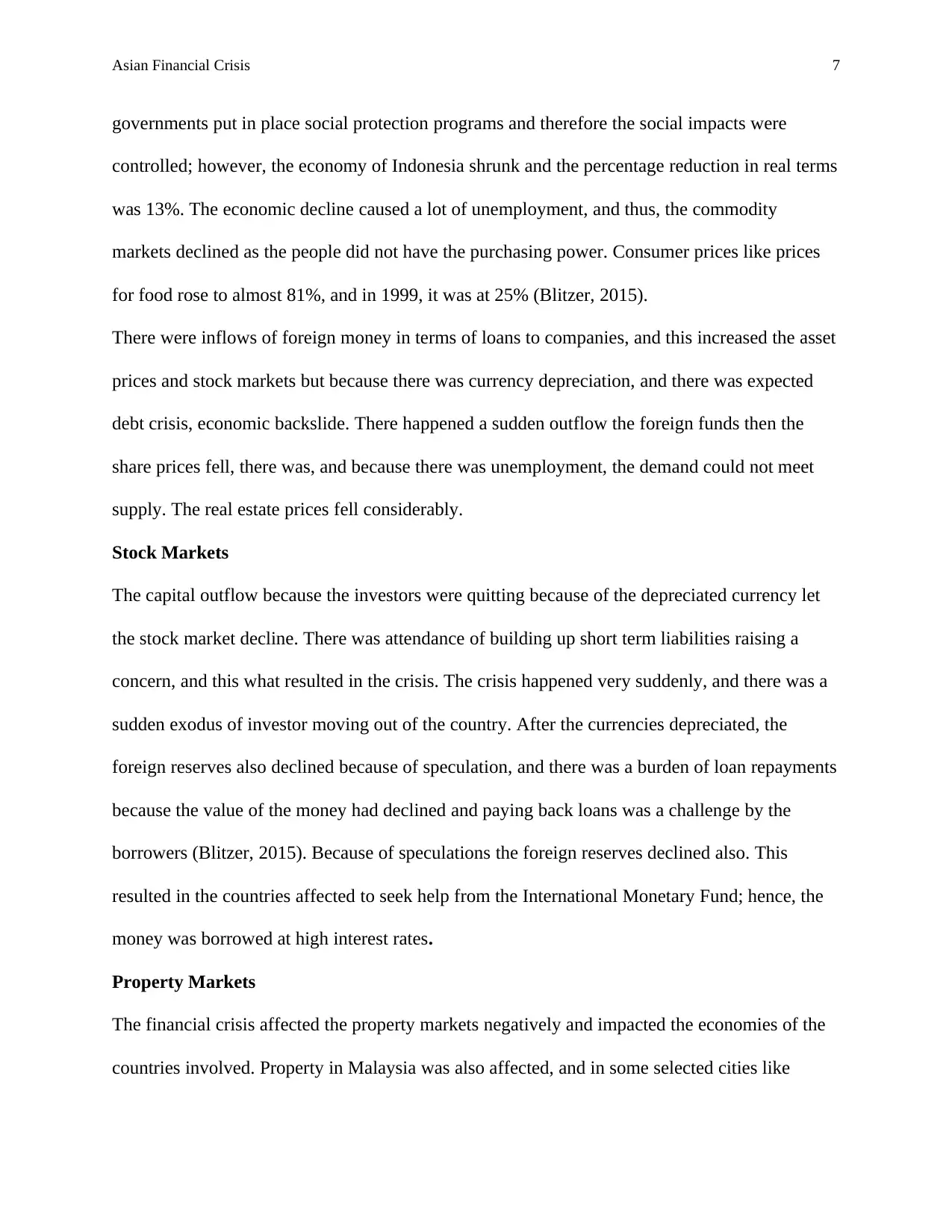
Asian Financial Crisis 7
governments put in place social protection programs and therefore the social impacts were
controlled; however, the economy of Indonesia shrunk and the percentage reduction in real terms
was 13%. The economic decline caused a lot of unemployment, and thus, the commodity
markets declined as the people did not have the purchasing power. Consumer prices like prices
for food rose to almost 81%, and in 1999, it was at 25% (Blitzer, 2015).
There were inflows of foreign money in terms of loans to companies, and this increased the asset
prices and stock markets but because there was currency depreciation, and there was expected
debt crisis, economic backslide. There happened a sudden outflow the foreign funds then the
share prices fell, there was, and because there was unemployment, the demand could not meet
supply. The real estate prices fell considerably.
Stock Markets
The capital outflow because the investors were quitting because of the depreciated currency let
the stock market decline. There was attendance of building up short term liabilities raising a
concern, and this what resulted in the crisis. The crisis happened very suddenly, and there was a
sudden exodus of investor moving out of the country. After the currencies depreciated, the
foreign reserves also declined because of speculation, and there was a burden of loan repayments
because the value of the money had declined and paying back loans was a challenge by the
borrowers (Blitzer, 2015). Because of speculations the foreign reserves declined also. This
resulted in the countries affected to seek help from the International Monetary Fund; hence, the
money was borrowed at high interest rates.
Property Markets
The financial crisis affected the property markets negatively and impacted the economies of the
countries involved. Property in Malaysia was also affected, and in some selected cities like
governments put in place social protection programs and therefore the social impacts were
controlled; however, the economy of Indonesia shrunk and the percentage reduction in real terms
was 13%. The economic decline caused a lot of unemployment, and thus, the commodity
markets declined as the people did not have the purchasing power. Consumer prices like prices
for food rose to almost 81%, and in 1999, it was at 25% (Blitzer, 2015).
There were inflows of foreign money in terms of loans to companies, and this increased the asset
prices and stock markets but because there was currency depreciation, and there was expected
debt crisis, economic backslide. There happened a sudden outflow the foreign funds then the
share prices fell, there was, and because there was unemployment, the demand could not meet
supply. The real estate prices fell considerably.
Stock Markets
The capital outflow because the investors were quitting because of the depreciated currency let
the stock market decline. There was attendance of building up short term liabilities raising a
concern, and this what resulted in the crisis. The crisis happened very suddenly, and there was a
sudden exodus of investor moving out of the country. After the currencies depreciated, the
foreign reserves also declined because of speculation, and there was a burden of loan repayments
because the value of the money had declined and paying back loans was a challenge by the
borrowers (Blitzer, 2015). Because of speculations the foreign reserves declined also. This
resulted in the countries affected to seek help from the International Monetary Fund; hence, the
money was borrowed at high interest rates.
Property Markets
The financial crisis affected the property markets negatively and impacted the economies of the
countries involved. Property in Malaysia was also affected, and in some selected cities like
Paraphrase This Document
Need a fresh take? Get an instant paraphrase of this document with our AI Paraphraser
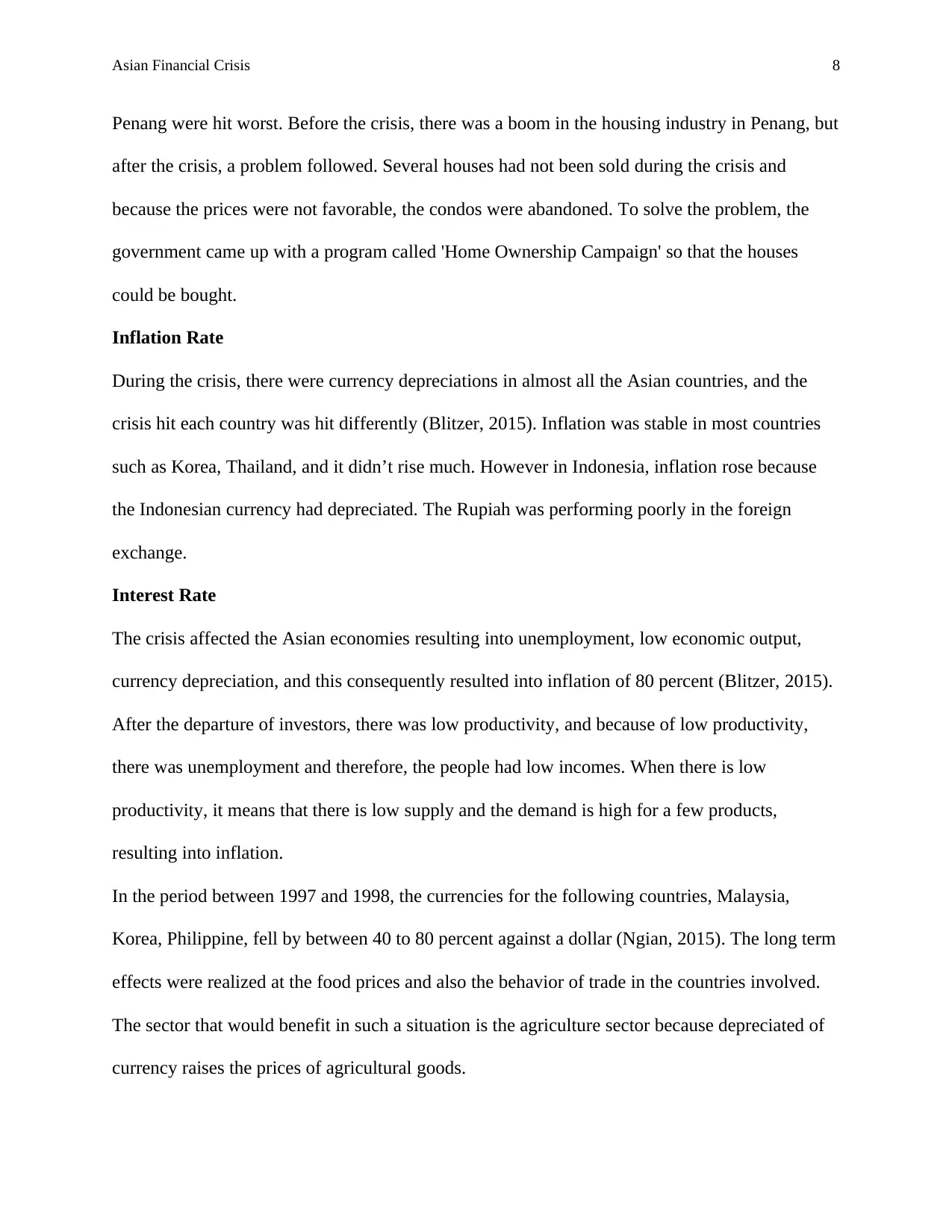
Asian Financial Crisis 8
Penang were hit worst. Before the crisis, there was a boom in the housing industry in Penang, but
after the crisis, a problem followed. Several houses had not been sold during the crisis and
because the prices were not favorable, the condos were abandoned. To solve the problem, the
government came up with a program called 'Home Ownership Campaign' so that the houses
could be bought.
Inflation Rate
During the crisis, there were currency depreciations in almost all the Asian countries, and the
crisis hit each country was hit differently (Blitzer, 2015). Inflation was stable in most countries
such as Korea, Thailand, and it didn’t rise much. However in Indonesia, inflation rose because
the Indonesian currency had depreciated. The Rupiah was performing poorly in the foreign
exchange.
Interest Rate
The crisis affected the Asian economies resulting into unemployment, low economic output,
currency depreciation, and this consequently resulted into inflation of 80 percent (Blitzer, 2015).
After the departure of investors, there was low productivity, and because of low productivity,
there was unemployment and therefore, the people had low incomes. When there is low
productivity, it means that there is low supply and the demand is high for a few products,
resulting into inflation.
In the period between 1997 and 1998, the currencies for the following countries, Malaysia,
Korea, Philippine, fell by between 40 to 80 percent against a dollar (Ngian, 2015). The long term
effects were realized at the food prices and also the behavior of trade in the countries involved.
The sector that would benefit in such a situation is the agriculture sector because depreciated of
currency raises the prices of agricultural goods.
Penang were hit worst. Before the crisis, there was a boom in the housing industry in Penang, but
after the crisis, a problem followed. Several houses had not been sold during the crisis and
because the prices were not favorable, the condos were abandoned. To solve the problem, the
government came up with a program called 'Home Ownership Campaign' so that the houses
could be bought.
Inflation Rate
During the crisis, there were currency depreciations in almost all the Asian countries, and the
crisis hit each country was hit differently (Blitzer, 2015). Inflation was stable in most countries
such as Korea, Thailand, and it didn’t rise much. However in Indonesia, inflation rose because
the Indonesian currency had depreciated. The Rupiah was performing poorly in the foreign
exchange.
Interest Rate
The crisis affected the Asian economies resulting into unemployment, low economic output,
currency depreciation, and this consequently resulted into inflation of 80 percent (Blitzer, 2015).
After the departure of investors, there was low productivity, and because of low productivity,
there was unemployment and therefore, the people had low incomes. When there is low
productivity, it means that there is low supply and the demand is high for a few products,
resulting into inflation.
In the period between 1997 and 1998, the currencies for the following countries, Malaysia,
Korea, Philippine, fell by between 40 to 80 percent against a dollar (Ngian, 2015). The long term
effects were realized at the food prices and also the behavior of trade in the countries involved.
The sector that would benefit in such a situation is the agriculture sector because depreciated of
currency raises the prices of agricultural goods.
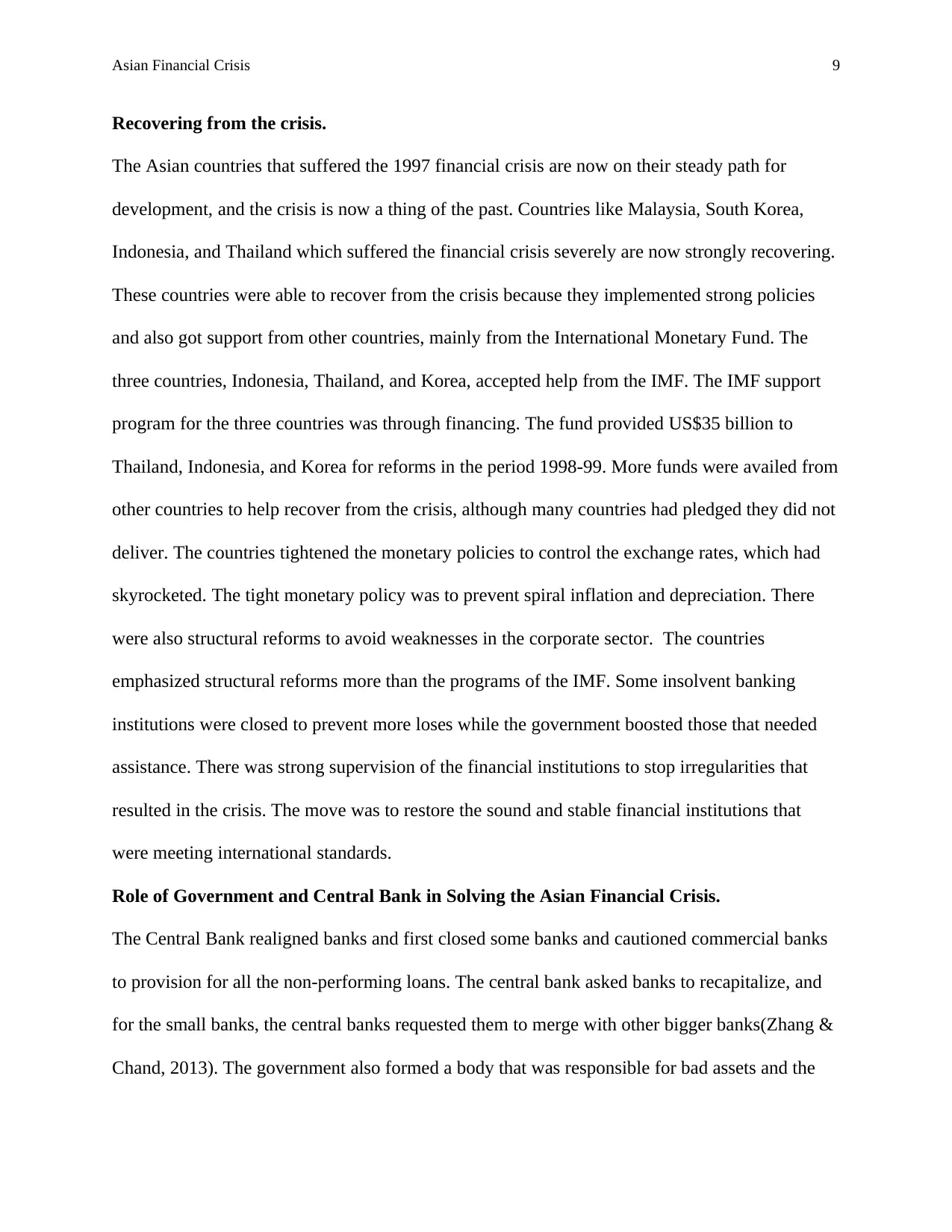
Asian Financial Crisis 9
Recovering from the crisis.
The Asian countries that suffered the 1997 financial crisis are now on their steady path for
development, and the crisis is now a thing of the past. Countries like Malaysia, South Korea,
Indonesia, and Thailand which suffered the financial crisis severely are now strongly recovering.
These countries were able to recover from the crisis because they implemented strong policies
and also got support from other countries, mainly from the International Monetary Fund. The
three countries, Indonesia, Thailand, and Korea, accepted help from the IMF. The IMF support
program for the three countries was through financing. The fund provided US$35 billion to
Thailand, Indonesia, and Korea for reforms in the period 1998-99. More funds were availed from
other countries to help recover from the crisis, although many countries had pledged they did not
deliver. The countries tightened the monetary policies to control the exchange rates, which had
skyrocketed. The tight monetary policy was to prevent spiral inflation and depreciation. There
were also structural reforms to avoid weaknesses in the corporate sector. The countries
emphasized structural reforms more than the programs of the IMF. Some insolvent banking
institutions were closed to prevent more loses while the government boosted those that needed
assistance. There was strong supervision of the financial institutions to stop irregularities that
resulted in the crisis. The move was to restore the sound and stable financial institutions that
were meeting international standards.
Role of Government and Central Bank in Solving the Asian Financial Crisis.
The Central Bank realigned banks and first closed some banks and cautioned commercial banks
to provision for all the non-performing loans. The central bank asked banks to recapitalize, and
for the small banks, the central banks requested them to merge with other bigger banks(Zhang &
Chand, 2013). The government also formed a body that was responsible for bad assets and the
Recovering from the crisis.
The Asian countries that suffered the 1997 financial crisis are now on their steady path for
development, and the crisis is now a thing of the past. Countries like Malaysia, South Korea,
Indonesia, and Thailand which suffered the financial crisis severely are now strongly recovering.
These countries were able to recover from the crisis because they implemented strong policies
and also got support from other countries, mainly from the International Monetary Fund. The
three countries, Indonesia, Thailand, and Korea, accepted help from the IMF. The IMF support
program for the three countries was through financing. The fund provided US$35 billion to
Thailand, Indonesia, and Korea for reforms in the period 1998-99. More funds were availed from
other countries to help recover from the crisis, although many countries had pledged they did not
deliver. The countries tightened the monetary policies to control the exchange rates, which had
skyrocketed. The tight monetary policy was to prevent spiral inflation and depreciation. There
were also structural reforms to avoid weaknesses in the corporate sector. The countries
emphasized structural reforms more than the programs of the IMF. Some insolvent banking
institutions were closed to prevent more loses while the government boosted those that needed
assistance. There was strong supervision of the financial institutions to stop irregularities that
resulted in the crisis. The move was to restore the sound and stable financial institutions that
were meeting international standards.
Role of Government and Central Bank in Solving the Asian Financial Crisis.
The Central Bank realigned banks and first closed some banks and cautioned commercial banks
to provision for all the non-performing loans. The central bank asked banks to recapitalize, and
for the small banks, the central banks requested them to merge with other bigger banks(Zhang &
Chand, 2013). The government also formed a body that was responsible for bad assets and the
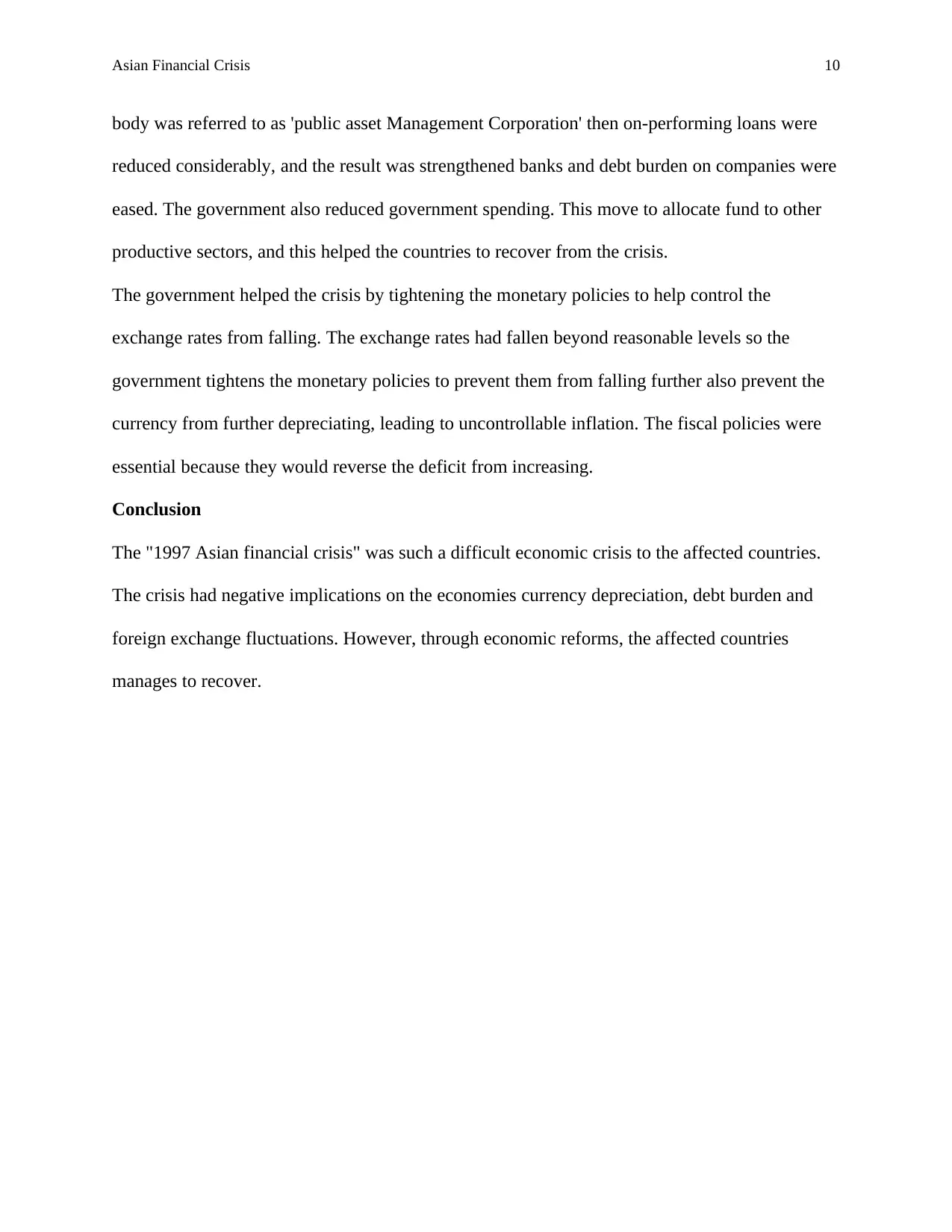
Asian Financial Crisis 10
body was referred to as 'public asset Management Corporation' then on-performing loans were
reduced considerably, and the result was strengthened banks and debt burden on companies were
eased. The government also reduced government spending. This move to allocate fund to other
productive sectors, and this helped the countries to recover from the crisis.
The government helped the crisis by tightening the monetary policies to help control the
exchange rates from falling. The exchange rates had fallen beyond reasonable levels so the
government tightens the monetary policies to prevent them from falling further also prevent the
currency from further depreciating, leading to uncontrollable inflation. The fiscal policies were
essential because they would reverse the deficit from increasing.
Conclusion
The "1997 Asian financial crisis" was such a difficult economic crisis to the affected countries.
The crisis had negative implications on the economies currency depreciation, debt burden and
foreign exchange fluctuations. However, through economic reforms, the affected countries
manages to recover.
body was referred to as 'public asset Management Corporation' then on-performing loans were
reduced considerably, and the result was strengthened banks and debt burden on companies were
eased. The government also reduced government spending. This move to allocate fund to other
productive sectors, and this helped the countries to recover from the crisis.
The government helped the crisis by tightening the monetary policies to help control the
exchange rates from falling. The exchange rates had fallen beyond reasonable levels so the
government tightens the monetary policies to prevent them from falling further also prevent the
currency from further depreciating, leading to uncontrollable inflation. The fiscal policies were
essential because they would reverse the deficit from increasing.
Conclusion
The "1997 Asian financial crisis" was such a difficult economic crisis to the affected countries.
The crisis had negative implications on the economies currency depreciation, debt burden and
foreign exchange fluctuations. However, through economic reforms, the affected countries
manages to recover.
Secure Best Marks with AI Grader
Need help grading? Try our AI Grader for instant feedback on your assignments.
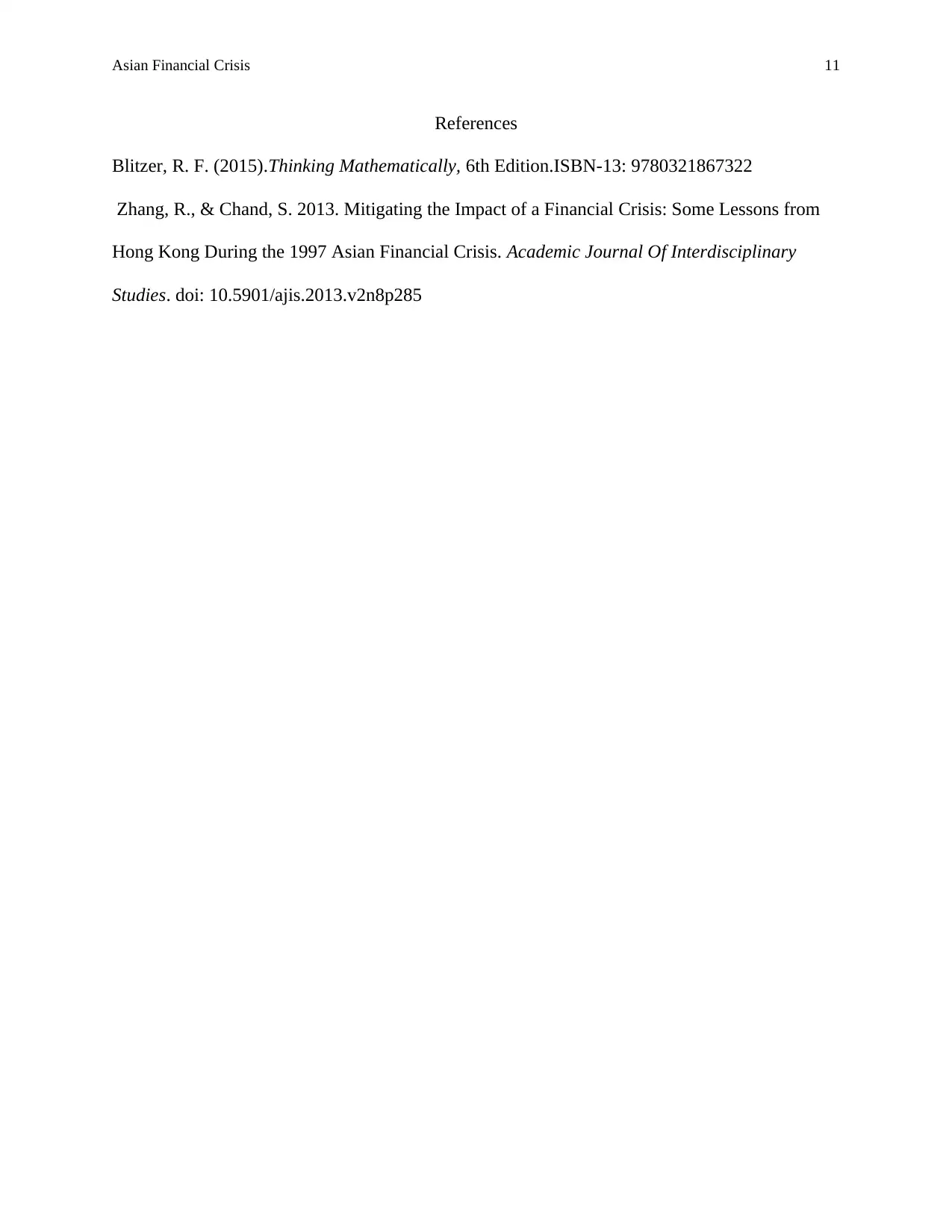
Asian Financial Crisis 11
References
Blitzer, R. F. (2015).Thinking Mathematically, 6th Edition.ISBN-13: 9780321867322
Zhang, R., & Chand, S. 2013. Mitigating the Impact of a Financial Crisis: Some Lessons from
Hong Kong During the 1997 Asian Financial Crisis. Academic Journal Of Interdisciplinary
Studies. doi: 10.5901/ajis.2013.v2n8p285
References
Blitzer, R. F. (2015).Thinking Mathematically, 6th Edition.ISBN-13: 9780321867322
Zhang, R., & Chand, S. 2013. Mitigating the Impact of a Financial Crisis: Some Lessons from
Hong Kong During the 1997 Asian Financial Crisis. Academic Journal Of Interdisciplinary
Studies. doi: 10.5901/ajis.2013.v2n8p285
1 out of 11
Related Documents
Your All-in-One AI-Powered Toolkit for Academic Success.
+13062052269
info@desklib.com
Available 24*7 on WhatsApp / Email
![[object Object]](/_next/static/media/star-bottom.7253800d.svg)
Unlock your academic potential
© 2024 | Zucol Services PVT LTD | All rights reserved.





